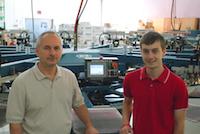To Protect & Serve
If there’s one aspect of manufacturing that’s almost universally relegated to last place in the minds of managers and employees, it’s maintenance. With the possible exception of managing labor costs, most of the emphasis is on increasing income. Relatively little time or energy is devoted to protecting assets.
However, if Ben Franklin had been a screen printer, his famously pithy quote might have gone, “A screen press saved is a screen press earned.” And with that attitude, you can bet Ben would have bought—and scrupulously maintained—an air chiller.
Do One Thing and Do It Well
Air chillers (refrigeration dryers) perform one simple but critical task: they remove moisture from the air. The process of pressurizing air causes the temperature of that air to rise, and the hotter the air, the less likely it is that the moisture it contains will condense and form water. However, as the pressurized air moves from the compressor into the air supply lines and on to pneumatic equipment (like your press), the compressed air begins to cool and the water vapor it contains begins to condense as the air passes through colder devices like pipes, valves, air switches, and other pneumatically-operated components. This part of the process is not unlike water vapor condensing on a cold bathroom mirror when hot water is turned on in a shower and water vapor saturates the air.
Failure to Chill
Unfortunately, the consequences for your equipment are far more serious than those for the mirror. Mechanical and electronic parts begin to corrode and electronic parts can short out or fall prey to other moisture-related failures. Eventually, those parts have to be repaired or replaced, and most warranties are rendered void by the use of air that has not been dried.
Replacement parts and the labor required to install them are expensive enough, but there is also the cost of downtime to consider. Corroded parts cause presses to be less energy efficient because they tend to consume more compressed air. However, a less efficient—but still operating—press is the best case scenario. Eventually, the best-case will become the worst-case: The press will stop operating, and the downtime cost becomes part of the equation.
The Will to Chill
The bottom line is that the costs related to installing and maintaining an air chiller are far less than the costs—direct and indirect—of running moisture-laden air through your pneumatic system.
How They Chill Out
Air chillers use refrigerant-cooled heat exchangers to condense water vapor, and they take more moisture out of the system than most people realize. For example, at 24o C (75o F) and 75% humidity, approximately 23 liters (6 gallons) of water can pass through a 25-HP compressor every 24 hours.
Most of the larger air chillers use a two-part heat exchange process. Although the primary goal is to lower the air temperature in order to condense the water vapor and remove the resulting liquid from the system, there’s a secondary goal, that of raising the temperature of that same air once it’s been dried. If the reason for chilling air is to remove water vapor from inside pneumatic systems, the main reason for reheating that air is to prevent water vapor from condensing on the outside of those same systems. Just as moisture will condense on a glass of ice water in a warm, humid room, moisture will collect on the outside of cold pipes, valves, and other pneumatic devices carrying cold air. Heating the air also helps ensure that any residual moisture in the compressed air remains in vapor form.
Doing the Two-Step
To accomplish this two-step process, air leaving the compressor exchanges some of its heat for some of the cold in the air leaving the chiller. By pre-chilling (bringing down the temperature of the air before it enters the chiller), the cost of getting the air down to the desired temperature is reduced. Likewise, air leaving the chiller is warmed (for free) by incoming air.
Chiller Killer
Although the point of this piece has been to encourage you to protect your pneumatic equipment with an air chiller, we’d like to point out that it’s as important to maintain the chiller as it is to maintain your printing equipment. All too often, M&R technicians respond to a repair call and find an air chiller that long ago stopped functioning properly and started passing moisture-laden air through the lines, destroying parts and putting presses offline.
We can’t emphasize enough how important it is to closely follow the manufacturer’s instructions for your air chiller. In addition to routine (and documented) maintenance, the chiller should be checked at the start of every shift. If the chiller is equipped with an auto-purge feature, it’s important to verify that the purge valve is working.
Failure to maintain air chiller can have devastating consequences. And if your shop has multiple automatic presses, keep in mind that if your chiller supplies air to all of them, someday you may find that all of your presses are failing and require immediate, repair.
Chiller’s Mantra
Take care of your chiller and it will take care of your presses. Take care of your presses, and they’ll take care of you.
The Chilling Question
The question isn’t, “Can you afford an air chiller?” It’s, “Can you afford to be without one?”

About the Author
President and CEO of M&R
Mr. Hoffman has more than 28 years of industry experience.



